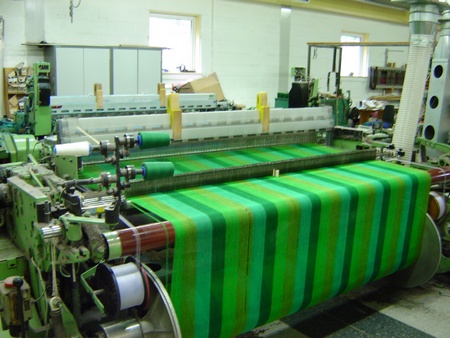In textile sector, weaving is the result of interlacement between two different sets of yarn that means warp and weft yarn. The fabric which is produced by using this interlacement technique is known as woven fabric. Weaving is the manufacturing process of woven fabric. There are different types of fabric produced in textile sector.
 |
| Fig: Weaving loom |
Difference Between Woven and Weaving:
In various textile interviews, one question has to asked by the recruiter that, “what is the difference between woven and weaving? There are so many who delivered the wrong answer in this case. The actual answer is that, woven is one kinds of fabric which is produced by interlacing warp and weft yarn and the process of woven fabric manufacturing is termed as weaving.
Flow Chart of Woven Fabric Manufacturing:
The actual process flow chart of weaving or woven fabric manufacturing has presented in the below:
 |
| Fig: Weaving flow chart |
All the above processes have discussed in the below:
Warp preparation:
The main purpose of warp preparation is to transfer yarn to a weaver’s beam from the spinner’s package which can be placed behind a loom ready for woven fabric manufacturing. Normally, a weaver’s beam contains at least a few thousands of ends.
Cone, cheese, pirn, cop winding:
It is a method of transferring yarns from cones, hank, and bobbins into a suitable form of package. Here, the length of yarn should be longer. Normally this process is used to form a single yarn package which will be suitable for the next processes.
Creeling:
It is the placement of full packages in position which is ready to be unwound as part of the transfer operations. In the other word, it is the removal of the exhausted packages and their replacement with full ones.
It is the placement of full packages in position which is ready to be unwound as part of the transfer operations. In the other word, it is the removal of the exhausted packages and their replacement with full ones.
Warping:
The parallel winding of warp yarn from so many winding packages such as cone, cheese, pirn, cop etc. into warp beam is known as warping.
Sizing:
It is the process of applying protective adhesive coating on the yarn surface is termed as sizing. Sizing increase the yarn strength, elasticity of yarn, weight of yarn etc.
It is the process of applying protective adhesive coating on the yarn surface is termed as sizing. Sizing increase the yarn strength, elasticity of yarn, weight of yarn etc.
Drafting:
In textile weaving sector, it is known as the selection of harnesses or heald frames for individual warp yarn according to the design.
Denting:
In woven fabric manufacturing industry, denting means drawing the warp yarn through the dent as per required by the reed plan. Denting determines more perfectly the width of the woven fabric and the ends per centimeter (EPI).
In woven fabric manufacturing industry, denting means drawing the warp yarn through the dent as per required by the reed plan. Denting determines more perfectly the width of the woven fabric and the ends per centimeter (EPI).
